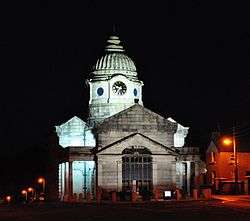Dunlavin
Dunlavin (Irish: Dún Luáin) is a village in County Wicklow, Ireland, situated about 50 kilometres (31 mi) south-west of Dublin. It is centred on the junction of the R412 and R756 regional roads. It was founded around the end of the 17th century and became a prominent town in the area for a time.
Dunlavin Dún Luáin | |
|---|---|
Village | |
 Dunlavin Market House by night | |
 Dunlavin Location in Ireland | |
| Coordinates: 53°03′20″N 6°42′14″W | |
| Country | Ireland |
| Province | Leinster |
| County | County Wicklow |
| Elevation | 158 m (518 ft) |
| Population (2016)[1] | 838 |
| Time zone | UTC+0 (WET) |
| • Summer (DST) | UTC-1 (IST (WEST)) |
| Irish Grid Reference | N868016 |
Rathsallagh House Golf & Country Club and the Wicklow National Park are both nearby. Dunlavin is also close to the Curragh and Punchestown racecourses in County Kildare. Dunlavin's unusually wide streets are characteristic of the village. The courthouse in the centre of the village, built in the Doric style of Grecian architecture, was built c.1740 and was formerly used as a market house.[2] The Dunlavin Festival of Arts, which is held each year in late June, has been running since 1982.
History
The settlement of Dunlavin was founded during the late 1650s by the Bulkely family from Cheshire (occasionally and erroneously referred to as "Buckley"). In 1702, Heather Bulkely married James Worth-Tynte and started the long association of the Tynte family with Dunlavin.[3]
In 1777 the Dunlavin Light Dragoon's were founded as a Volunteer corps, which were raised to defend Ireland from French invasion.[4]
The Massacre of Dunlavin Green occurred in 1798. The Catholic Church (dedicated to St Nicholas of Myra) was built on adjacent land donated by the local Tynte family. The church dates from 1815, although Catholic worship was observed on the site prior to this.
Education
There are local schools: Jonathan Swift National School (primary, with a Church of Ireland ethos), St. Nicholas of Myra National School (primary, with a Catholic ethos), St. Kevin's Community College (secondary and vocational) and a preschool located beside Jonathan Swift National School.
Transport
Rail
Dunlavin railway station opened on 22 June 1885, as part of the line from Sallins to Tullow. It closed to passengers on 27 January 1947 and to goods traffic on 10 March 1947, and closed completely on 1 April 1959 along with the rest of the line.[5] The station building is now a private residence.[6]
Road
Classic and vintage motor enthusiasts are catered for by the West Wicklow Classic & Vintage Vehicles Club.[7] The scenic R756 road leads from Dunlavin to Glendalough crossing the Wicklow Gap.
People
- Raymond Daniels, Wicklow Gaelic footballer (1979–2008) was born in Dunlavin
- Fr. John Francis Shearman, the historian served as a curate in Dunlavin, and researched early Christian relics around Dunlavin.[8]
See also
- List of towns and villages in Ireland
- Market Houses in Ireland
References
- "Sapmap Area - Settlements - Dunlavin". Census 2016. Central Statistics Office. April 2016. Retrieved 1 April 2020.
- "Dunlavin Market House (Dunlavin Courthouse), Market Square, Main Street/Kilcullen Street, Dunlavin, County Wicklow". buildingsofireland.ie. National Inventory of Architectural Heritage. Retrieved 1 April 2020.
- Lawlor, Chris (31 May 2008). "An Irish Village". Retrieved 2008-08-28.
- Bigger, Francis Joseph; The National Volunteers of Ireland, 1782, Ulster Journal of Archaeology, Second Series, Vol. 15, No. 2/3 (May, 1909)
- Ayres, Bob (2003). "Irish Railway Stations" (PDF). Railscot. Retrieved 12 October 2007.
- "Dunlavin". eiretrains.com. Retrieved 3 October 2016.
- "www.westwicklowclassics.com". Archived from the original on 2017-10-01. Retrieved 2019-07-30.
- A chronicler of Dunlavin – Fr. John Francis Shearman
